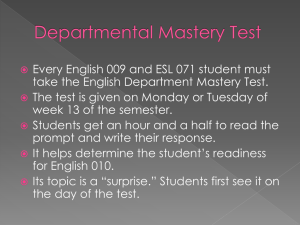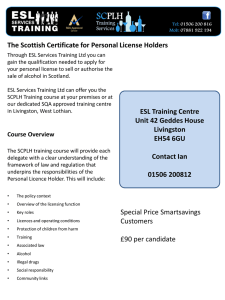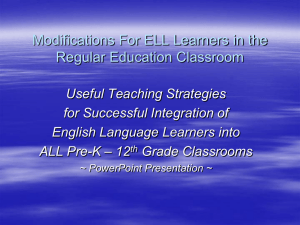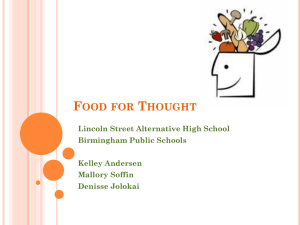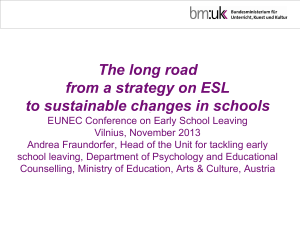Overview of English as a Second Language Program
advertisement
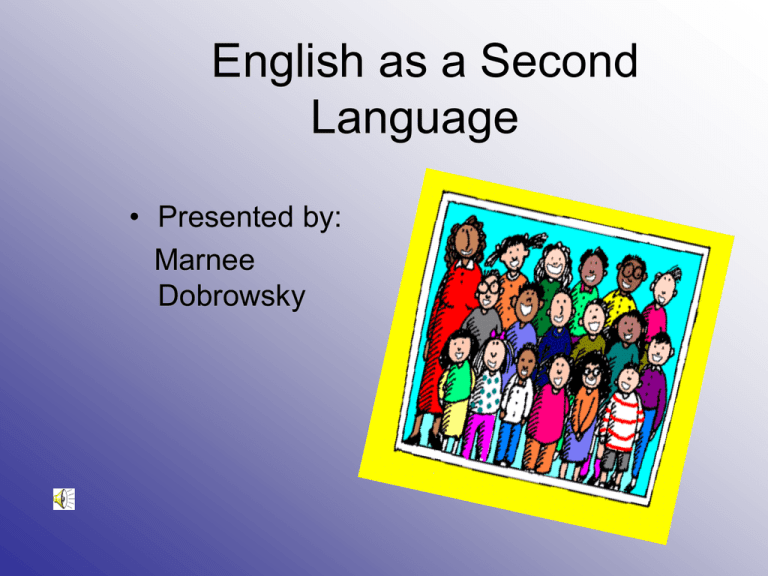
English as a Second Language • Presented by: Marnee Dobrowsky Overview Topic: ESL Program Review and Development for Adult Educators Audience: Regular classroom teachers, administrators, specialty area teachers, and counselors, parents Purpose: *To acquire knowledge and determine teaching methods for the culturally diverse student and classroom environment. To collaborate with peers and extend the learning theories into the classroom. This overview will allow for a better understanding on how to integrate a variety of activities and content lessons into the curriculum, become familiar with state mandates and TESOL standards, and implement several teaching techniques into a diverse classroom. Topics: *What is English as a Second Language Overview (Terminology) *Identification Procedures for ESL Students * Placement of ESL Students (W-APT Evaluations/WIDA ACCESS TESTS) *Implementing the Program (Expectations of Teachers) *Techniques, Materials, and Accommodations *Ways to collaborate and how to integrate ESL and Content *Exiting and Monitoring the ESL student What is English as a Second Language? • ESL or ELL may stand for English as Second Language or English Language Learners • Students that have a primary language other than English can be serviced in all states • This is available in all grade levels, K-12. Concerns for the ESL Teacher Concerns for the Classroom Teacher Identifying ESL Students Home Language Surveys Home language Only identify easy Limited English Other than Words and schooling English sentences All students must bring back a completed home language survey to be viewed for possible evaluation. Placement of ESL Students • W-APT WIDA Placement Evaluations • Levels of abilities • Time and grouping of students • Try to ideally replace Language Arts or Foreign Language classes • After determining proficiency of Reading, Writing, Speaking, and Listening skills, placement will occur. • Students serviced in an ESL program are given the WIDA ACCESS yearly to determine proficiency levels and progress towards exiting Implementing the ESL Program • • • • Creating schedules Choosing ESL curriculum Choosing grade level curriculum Collaborating with content area teachers • Collaborating with administration Bringing the Expertise Together • Mainstream • ESL Teacher > Content Knowledge > Strategies for differentiation > Cultural knowledge > Language Acquisition Theory > Learning expectations > Availability of a variety of learning materials > Class management Techniques Levels of English Proficiency Entering: Knows minimal social and academic language with visual support Beginning: Knows and uses some social English and some general academic language with visual support Developing: Knows and uses social English and some specific academic language with visual support Expanding: Knows and uses social English and some technical academic language Bridging: Knows and uses social and academic language working with grade level materials and core content Reaching: Knows and uses social and academic language at grade level to the fullest potential NOTE: Students at a Bridging or Reaching level are usually fully functioning in all academic areas in regular classroom settings and have, or are about to exit the ESL program. Teaching Strategies READING -Organized in content-based thematic units -Multilevel reading groups (Leveled Readers) -Whole language with phonics components WRITING -Teach the writing process -Use journal responses -Use language experience Approach -Combine drawing and writing Assessment in Collaborative Settings • TESTING OPTIONS Performance rather than score based Word banks, for openended, cloze, and multiple choice Teacher modified tests Multiple test forms “Think Aloud” reflections • GRADING OPTIONS Double Grading (ESL and Mainstream Portfolio Assessments Rubrics Performance Checklists Oral, rather than pencil and paper tasks Observation checklists Techniques to Accommodate ESL Students • Review packets and Book • Allow for extended time • Modify tests and assignments ( **See Case Studies) • Grading procedures • Authentic ways of assessment • Modeling/Variety of activities • Interactive Websites (Hand-out) Evaluation Example (Vocabulary Strips) FORECAST NOUN The weather forecast called for warm temperatures and sunny skies. Curriculum Implementation Align to PA and TESOL standards Lesson plans and Objectives for Each grouping Integrate content And technology Report cards, Progress reports, Monitoring TESOL’s Goals and Standards for PreK12 Students Goal One: To use English to communicate in social settings *Participate in social interactions *Personal expression-spoken and written *Use appropriate learning strategies and styles TESOL’s Goals and Standards for PreK12 Students Goal Two: To use English to achieve academically in all content areas of instruction *Interact in the classroom *Obtain, process, construct, and provide subject matter information in spoken and written forms *Use grade level and appropriate learning strategies TESOL’s Goals and Standards for PreK12 Students Goal Three: To use English in socially and culturally appropriate ways *Use appropriate language variety, register, and genre according to setting, audience, and purpose *Use appropriate nonverbal communication for audience, purpose, and setting. *Use appropriate learning strategies to extend sociolinguistic and socialcultural competence TESOL STANDARDS CAN BE FOUND AT: http://www.gisd.k12.nm.us/standards/esl/ http://www.helpforschools.com/ELLKBase/guidelines/ESLStandardsforPreK12.shtml Collaboration with Staff and Parents • Communication Logs • Conduct ESL staff development • Parent involvement • Open communication with administrators • Report cards and progress reports • Work together on goals and objectives UNDERSTANDING BICS AND CALPS “BICS”- Basic Interpersonal Communication Skills Conversational fluency Functional level after about two years “CALPS”- Cognitive Academic Language Proficiency Grade appropriate academic fluency in second language At least five years to be functional with native speakers in content area Failure to account BICS/CALPS-- Result in discriminatory assessments of bilingual students Premature exit from language support programs to mainstream classes Materials • Hands-on manipulatives • Use of technology • Models, designs, and examples • Relate to real experiences • Phonics • Hampton-Brown or Scott Foresman core themed curriculum • Supplement materials • Vocabulary • Graphic Organizers • Rubrics • Authentic Assessments Exiting ESL Students (BEC Circular) • Proficiency and passing score of a Level C WIDA ACCESS state exam • Demonstrates Reading, Writing, Speaking, Listening proficiency in mainstream classes • Maintains adequate grades in content area subjects • Conferences with teachers, parents, administration • Score of Basic or above on PSSA exams • Exits into mainstream classroom with monitoring Monitoring ESL Students • Monitoring forms for elementary and secondary • Obtain grades and progress for each nine weeks from content area teachers in each subject • Adequate content area grades • Standardized tests • Contact with student, counselors, and teachers • Score of Basic or Proficient on PSSA exams Benefits for ESL and Mainstream Teachers • • • • • • • • Support Collaboration Team Work Professional Growth and development Sharing responsibility Students learn from two experts Meeting the diversity of all student learning needs Evidence of student progress and growth Bibliography Ariza, E., Morales-Jones, C., Yahya, N., & Zanuddin, H. (2002). Fundamentals of Teaching English to Speakers of Other Languages in K-12 Mainstream Classrooms. Dubuque: Kendall/Hunt Publishing. Brockett, R. & Merriam, S. (1997). The Profession and Practice of Adult Education. San Francisco: Jossey-Bass. Educating Students with Limited English Proficiency (LEP) and English Language Learners (ELL). (2001). (n.a.) Retrieved from http://www.pde.psu.edu/BECattach/PC426lep&ell.html O’Malley, J.M., & Pierce, L.V. (1996). Authentic Assessment for English Language Learners: Practical Approaches for Teachers. Cleveland: Addison Wesley Publishing. Ovando, J. Collier, V. P. & Combs, M. C. (2003). Bilingual and ESL Classrooms: Teaching in Multicultural Contexts. McGraw-Hill Publishing. TIP-Theories. (n.d.) Retrieved on November 10, 2005 from http://tip.psychology.org



